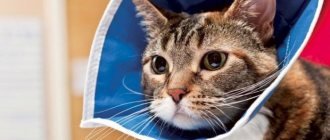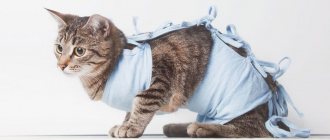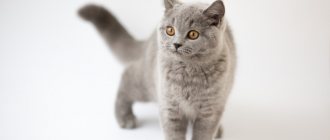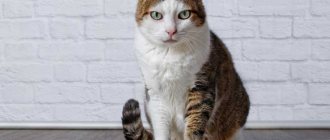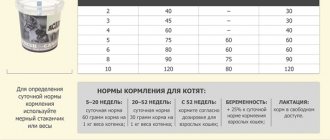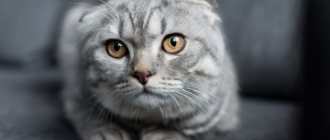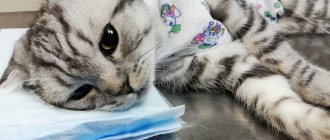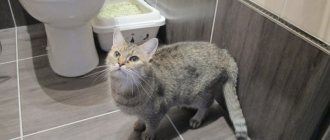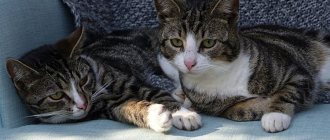Quite a lot of owners are faced with the need for surgery in cats. The main surgical procedure is spaying or neutering cats. However, sometimes surgery is the only way to cure a cat or improve its living conditions.
Everyone knows that before any operation the animal must be examined: a doctor’s examination, blood tests, heart screening. However, few people think that proper care of the cat after surgery is also important. The recovery of a cat depends not only on veterinarians, but also on the owners, who will properly care for the cat after surgery and perform all prescribed manipulations. Any surgical intervention is always a great stress for the body. So how can you help your beloved cat after surgery?
Symptoms of obstruction
- increasing vomiting
- loss of appetite to the point of complete refusal to eat
- no or little stool
- deterioration of general condition
- painful enlarged belly
What to do?
At the slightest suspicion of an obstruction (especially if you know that your pet had the opportunity to eat something “wrong”) - run to the clinic! What not to do? Do not try to feed or water the cat - this will only provoke vomiting. Do not give an enema, as this may cause intestinal rupture. Do not give a laxative that increases contraction of the intestinal muscles. Do not use antiemetic drugs, which will only mask the symptoms without providing a therapeutic effect.
Diagnosis of obstruction
With symptoms of acute obstruction, this dangerous disease is always ruled out first.
The diagnosis is made based on clinical symptoms and examination by a doctor. Careful palpation will determine the “acute abdomen” and painful area. Blood tests are needed to assess the cat's condition and identify concomitant diseases. If obstruction is suspected, an x-ray of the abdominal cavity, for better information, with a contrast agent.
If all these studies do not make it possible to make an accurate diagnosis, what remains is diagnostic laparotomy (as they say, “an autopsy will show”) - an incision in the abdominal cavity - a surgical operation under general anesthesia, which will reveal the pathology.
Avatar So, while we were dripping (2 hours, no less), the test results became ready. Everything is normal, with minor deviations that can be attributed to vomiting and hunger strike. A thorough examination by the doctor and palpation revealed a painful area in the abdomen. In general, the dire diagnosis of obstruction is becoming more and more clear. We go for an x-ray, having previously pumped ourselves up (20 ml) with a contrast agent.
Why is a contrast agent needed? In the animal's body, along with bone tissue, which gives a clear shadow picture during radiography, there is also soft tissue that creates a less dense shadow. Therefore, if tissues and organs are approximately the same in density, then their boundaries are difficult to distinguish on an x-ray. This also applies to the abdominal organs - liver, stomach, intestines, etc. How can we discern changes in them? For this purpose, substances with high atomic weight are used, creating a difference in density between the desired organ and the rest of the environment.
Barium sulfate is often used as a contrast agent for examining the gastrointestinal tract. It is a chemically pure, harmless, insoluble white powder, odorless and tasteless.
Avatar In the process of feeding the cat with a cocktail of water and barium, everything was smeared - the table, chair, floor, carrier, me, the doctor and, finally, the cat itself. It’s good that dried barium is easily cleaned like chalk.
Of course, no one deliberately gave him a dangerous “yummy.” It was just unwise to leave it on the table. The avatar himself cannot get anything from the table, but he has four-legged friends who helped him.
What to do? After consulting, we decide with the doctors to give Vaseline oil a chance, considering that it may work for my cat. Once again we drip for a long time, drink the oil and go home.
At home, the Avatar's condition worsens. He literally howls and starts vomiting again. My stomach is so bloated that I understand that Vaseline oil is not an option. After a disturbing night, we are at the clinic early in the morning. We dig in again and go to the operation.
Treatment of obstruction
Treatment begins immediately, even before diagnosis. This includes infusion therapy (droppers) to replenish the loss of water and nutrients, painkillers and anti-inflammatory drugs, and antibiotics.
In severe cases, when intestinal blockage threatens the life of the animal, emergency surgery is indicated. Sometimes this involves removing the affected part of the intestine.
The postoperative period includes a fasting diet for 12-24 (sometimes more) hours, again intravenous drips, and antibiotics. Next - careful feeding with semi-liquid food. For 14 days it is necessary to monitor the condition of the sutures, which are then removed.
Avatar Avatar now has a “colleague” in the operation - a calico cat Monya, whose x-ray shows... the same foreign body as his. Ha-Ha! They go under the knife one after another.
I photographed the trophies after they were removed. Here they are. Avatarkin is on the left, Moni is on the right. Apparently, the sausage brace is a hit among foreign bodies in cats
The operation was successful, the sausage element was removed, there was no necrosis of the intestinal tissue - only two reddish dots from the metal pressure (that's what it means to react in time!). The avatar is resting. He was kept in hospital overnight. After recovering from anesthesia, he was prescribed an enema (a lot of feces had accumulated) and, of course, an IV.
Avatar, unlike other cats who have undergone surgery, does not need a post-op blanket because he cannot lick his belly. And a sick antibiotic can be given to him in the back muscle - there is no deep sensitivity. At least there are some advantages to paralysis.
The next day after the operation, the cat feels well, is active, moves his head, is interested in everything - cannot be compared with his recent state, when he was lethargic and apathetic. Morning and evening - endless droppers. Finally, after grabbing an infusion solution and an antibiotic, we go home. Hooray!
At home, the cat behaves as if there was no serious surgery. Let's dig on our own. How easy it is for doctors, and how difficult it is for a layman! We cope with sin in half.
I carefully begin to feed her with Royal Canin Recovery pate (1-2 teaspoons every 2-3 hours). The appetite is excellent. The whole family breathed a sigh of relief. We rejoice. But in vain!
By the evening of the next day - complete refusal of food. In the morning we go to the clinic again. We donate blood and sit down to take a bath. The tests are normal, the treatment is drips, drips and more drips. The antibiotic continues in a continuous course. By evening the cat begins to eat.
At home now. We continue IVs, antibiotics, soft nutrition. The avatar feels great and is already chasing cats. True, he’s still weak, he rests a lot, but that’s normal. The seam is fine, although slightly dented. It looks like the obstruction story is coming to an end. Pah-pah-pah...
Do you think she will teach the Avatar something and he will learn some lesson? No matter how it is! If someone drew conclusions, it was not the victim, but his owners, that is, us.
Normal body temperature in cats
A cat’s normal temperature is 38-39 degrees, and the indicators depend on many factors and can change during the day. For example, a cat that is sleeping or has just woken up will have lower levels because the animal does not expend energy while sleeping.
During active games, the temperature rises. The same thing happens to an animal’s body as to a person during physical activity. There is no need to worry about your pet; as soon as he calms down, the t readings will return to normal.
The kitten's body temperature will always be higher than normal. The little ones learn about the world, experience a lot of emotions, are extremely active, and this is the reason for the mild and harmless fever.
During the period of estrus, pregnancy, childbirth, after sterilization surgery and vaccinations, cats usually experience a sharp jump in body temperature. But you should worry if the thermometer shows more than 40 °C for 3-4 days.
Important! The thermoregulation mechanism in kittens develops over time, so a slight increase in indicators is considered normal. The situation stabilizes by the age of 6-7 months.
| Breed, age of cats | Normal t in degrees |
| Newborns | 35,5-36,5 |
| 1-2 months | 38,5-39,5 |
| 7-8 months | 39-39,5 |
| From 5-6 years | 38-39 |
| Sphynx cats | 39-39,5 |
| Cats of wool breeds | 38,5-39,5 |
Thus, the normal temperature for a cat is 39 degrees. The skin of Sphynx cats seems hotter, but only due to the lack of a fur layer. A healthy hairless cat should not have a body temperature higher than 39.5.
Tip 1: What to feed your cat after surgery
- Fresh baked goods, especially muffins.
- Fatty meats.
- Dishes containing large amounts of salt and spices, as well as all types of smoked foods.
- Raw milk (homemade), fatty dairy and fermented milk products, cheese.
- Crumbly and bean porridges, pasta.
- Vegetables, including raw ones (especially cabbage, tomatoes, asparagus).
- Mushrooms.
- Nuts.
- Fatty soups. Cold, milk and bean soups.
- Cocoa, coffee, grape juice, carbonated and chilled drinks.
Slimy soup
A gentle, balanced diet is important for a pet that is recovering from surgery. After surgery, cats are characterized by weakness and drowsiness, and the pet becomes inactive.
Any surgical intervention is a great stress for the animal’s body. How quickly your pet will recover depends on the complexity of the procedure and the quality of post-operative care. How to do everything right and help your cat recover faster?
1. Strictly follow your veterinarian's recommendations.
The word of a veterinary specialist is law. Follow the recommendations and do not self-medicate. If the doctor has prescribed antibiotics for your cat, give it antibiotics for exactly as many days as prescribed, even if it seems to you that the pet has already recovered. All instructions must be followed - the success of rehabilitation depends on this.
2. Monitor your pet's condition.
If possible, take time off for the first few days after surgery. A weakened cat will need your help and careful monitoring of its condition: temperature, stool, stitches, etc. You should always have the veterinarian’s phone number at hand. In case of deterioration or if you have any questions, be sure to contact him.
Important Tips
After surgery, cats should not be fed dry food, although it is obvious, some owners make this mistake. On a natural diet, protein should remain the basis of the diet (just like a healthy cat), but it needs to be supplemented with carbohydrates. What to do if your cat refuses new foods? There are several solutions - add a little sugar to the water or make droppers with glucose. By the way, an injectable glucose solution can be offered as a drink; the effect is slightly lower, but it is there.
Important nuances that everyone needs to remember are:
- Fractional feeding - less, but more often.
- Easy to digest - it will be very good if, during the rehabilitation period, cats are switched to a diet of foods that are quickly and almost completely digested.
- Smell – food should smell delicious.
- Freshness – we prepare natural food only for one day, especially for broths.
- Food temperature - food should be warm, so it is better digested and smells stronger.
Important! Never force your cat to eat, even if you think she hasn't eaten well.
When your pet starts eating from a bowl, you shouldn’t stretch out the meal time; 10–20 minutes is enough for the cat to eat as much as she wants.
Only registered users have the ability to start new topics. Register and log in to the site by entering your username and password on the right side of the window, and you can start a new topic.
Before visiting the forum, read the topic: “How to properly consult a veterinarian,” as well as the list of answers to frequently asked questions, this will help you save your time and get an answer to your question faster. Pay special attention to the document: Symptoms of animal diseases. Perhaps in your situation you cannot expect an answer on the forum, but you need to urgently call a doctor or take the animal to a veterinary clinic!
Before joining the forum, read the following sections, this will help save your time and quickly get an answer to your question:
Attention! Pay special attention to the document “Symptoms of Animal Diseases”. Perhaps in your situation you cannot expect an answer on the forum, but you need to urgently call a doctor or take the animal to a veterinary clinic!
To come in
Prevention of obstruction
Dear cat owners! If you don’t want terrible torment for your pet, and for yourself - a big headache in the form of moral suffering, as well as a huge investment of time and money (I’m afraid to even think how much the treatment would have cost me if I hadn’t worked in the clinic! ), then simply do not allow this dangerous situation to arise. Make small, inedible objects that your pet might swallow inaccessible.
Of particular interest to cats are sausage casings, feathers, pieces of paper and foil, rubber bands, strings and threads.
Threads with a needle are especially dangerous - they can cause damage to the gastrointestinal tract and even “stitching” of the intestines.
And a completely separate conversation - Christmas tree rain. However, the New Year is generally a source of many dangers for our pets - more about that here.
Conclusion: Please be vigilant and do not leave anything “criminal” even by accident. Don't give this terrible intestinal obstruction a chance!
What to do if you have hyperthermia (high temperature)
If your cat has a fever after surgery, move the animal to a cool place, but just make sure there are no drafts. Dry your cat with a damp towel. Place a bowl of cool water.
If your cat's temperature is high, you should absolutely not give your pet human medications to relieve fever.
Important! Analgin, aspirin, paracetamol, and other drugs that contain acetylsalicylic acid can cause poisoning and intoxication.
In addition, it is very difficult to guess the correct dosage of antipyretic drugs. The doctor will prescribe the necessary medications after an examination and depending on the underlying cause.
Announcements on NN.RU - Home
In good technical condition, matrix without scratches Silver color Diagonal 19″ Resolution 1280×1024 (5:4) Brightness 300. Price: 3,000 rub.
Gaming laptop acer nitro 5 AN515-52 black The laptop is completely new, the photo shows the operating time (16 hours, 26 days). Reason for sale. Price: 48,000 rub.
Sublimation printer Zebra P330i -0000A-IDO for spare parts, print head holder is broken Price: 50,000 rub.
In good working order Color silver, black stand Diagonal 19″ Resolution 1280×1024 (5:4) Brightness 300. Price: 3,000 rub.
A pensioner disappeared without a trace in Nizhny Novgorod. PSG "Lynx" announces the start of search activities.
The next five days the weather will not bring any wild surprises. By October standards, the working week will be quite warm: air temperature.
Do you want to celebrate Halloween in an unusual way? It's time to head to MOTIONGATE™ Dubai! The highest levels await thrill-seekers there.
The legendary cafe, located near the wall near the Dmitrov Tower and loved by many Nizhny Novgorod residents since Soviet times, was demolished yesterday.
The story is based on true facts. I am writing “hot on the heels” because this is happening to my cat right now.
The insidiousness of intestinal obstruction is that it can happen not anywhere, not to anyone and not ever, but to any cat, to any cat and at any moment. And your pet is no exception. God grant that this never happens, but it is better to be prepared and in case of trouble to know what to do.
How to reduce a cat's fever at home
If the cat has a high temperature, you should not wet the cat’s fur or wrap the animal in a damp towel, use folk remedies, or independently reduce the fever with medications intended for treating humans.
And now about how to help and what you can give your cat when a fever appears:
- Place your pet in a cool room. The optimal air temperature should be about +20 °C. If an animal is overheated in the sun, it is strictly unacceptable to immediately bring it into a cold room. It is best to place the cat in a chair or on a bedding, gradually lowering the air temperature to +18 degrees. Windows and doors should be closed - a draft will provoke a cold.
- Give plenty of warm fluids in doses of no more than 1 tsp. with a frequency of 1 time every 20-30 minutes. It should be clean, cool (but not cold) water. Water should be given to cats with a syringe without a needle - bring the nose of the syringe to the mouth, lightly press with your fingers on the corners of the jaws so that the pet opens its mouth. Some owners give water with a pear, but in this case there is a risk of giving the cat water with air.
- Take care of a light diet. Remove dry cat food and natural food, but leave light chicken (warm) broth - this food will help the cat regain strength.
Important! Symptoms of dehydration: vomiting, diarrhea, severe fever, tremors, lack of urination.
If dangerous symptoms are observed and the body temperature cannot be reduced, the animal should be shown to a veterinarian. It is strictly unacceptable to treat your pet on your own.
Intestinal obstruction
- this is a complete or partial cessation of the movement of contents through the intestines. The most common cause is foreign body blockage. This is followed by blockage as a result of a tumor, volvulus, hernia or intussusception (penetration of one part of the intestine into another), etc.
Mechanical blockage with a foreign body reveals itself suddenly, out of the blue. How this happened a few days ago with my cat Avatar. Who is the cat Avatar and what is special about him - see here, it will be interesting.
Avatar During the day, vomiting suddenly began. At first I didn’t attach any importance to this. Well, I vomited once, who doesn’t? Again. Already alarmed. And I got really worried when the cat flatly refused to eat, without even looking towards the bowl. To test, she offered an impossible delicacy - a piece of chicken. Decisive refusal. Everything is bad!
Vomiting continued at night. And the next morning we were already at the clinic. They immediately took blood for analysis and put me on a drip without talking. Why?
Why is obstruction dangerous?
When a blockage occurs, juices continue to be released, but now, unable to move and be absorbed, they accumulate in the stomach and small intestine, causing vomiting. With vomiting, a large amount of fluid and nutrients (especially potassium) is lost, rapid dehydration and weakening of the body occurs.
Drinking water does not help, but only makes vomiting worse. Without treatment within 2-7 days the animal will die.
Therefore, in case of serious disturbances in the functioning of the gastrointestinal tract (especially in case of obstruction!), abundant intravenous infusions are needed to replenish fluid.
- In addition, at the site of blockage, due to poor circulation in the affected area, necrosis may occur - tissue death of the intestinal wall, which will develop rapidly, which will also worsen the condition of the animal.
- And further. It happens that the presence of a foreign body in the intestines leads to its decomposition, oxidation, etc. and the release of toxic substances from it, which contributes to additional intoxication of the body.
- Obstruction (as well as chronic constipation) provokes the proliferation of putrefactive and other harmful bacteria, which leads to serious disruption of the intestinal microflora.
The closer the blockage is to the stomach, that is, the larger part of the intestine is closed, the more severe the disease.
International Veterinary Center for Reproduction and Artificial Insemination of Small Animals
CLINICAL CASE – FOREIGN BODY OF THE SMALL INTESTINE IN A CAT Perepechaev K.A. Ph.D., Menshenina E.S.
2012
Disease history:
A 1.5 year old, sterilized, outbred cat was admitted.
Contents: home, apartment.
Vaccination: comprehensive + rabies.
Feeding: ready-made food (Pro Plan).
Complaints:
According to the owners, 7-10 days ago the cat chewed a soft rubber toy. For 24 hours after this, the cat was lethargic and refused to eat. The next day there were 2-3 bouts of vomiting. Small pieces of rubber came out with the vomit. After this, the cat’s condition returned to normal, and her appetite and physical activity were restored. 36 hours ago, the cat began to vomit frequently saliva and bile (5-6 times a day). The animal refused to eat. The owners took an x-ray at the veterinary clinic closest to their place of residence and brought the cat to our center 24 hours ago.
Diagnostics:
General condition: satisfactory, no signs of dehydration or intoxication, lethargy, drowsiness, temperature (rect) 38.9o C.
According to the X-ray results: there are no obvious signs of a foreign body, there are areas of compaction in the area of the stomach and small intestine, and there is an accumulation of gases in the intestines.
According to the results of ultrasound of the abdominal organs: gas formation in the stomach; abnormal peristaltic “pendulum” movements in the small intestine are a sign of a foreign body.
On palpation: the abdomen is soft, the intestines are collapsed. When pressing in the area of the stomach and small intestine, the animal experiences some discomfort.
According to the results of blood tests: General clinical blood test – normal; Biochemical analysis - increased concentration of liver enzymes (ALT, AST).
Differential diagnosis: post-traumatic gastroenteritis or foreign body of the stomach or small intestine.
Healing procedures:
After placing an intravenous catheter, intensive infusion therapy (administration of plasma replacement solutions, antibiotics, analgesics, etc.) was carried out for 1.5 hours. A starvation diet was prescribed. Water intake is allowed (fractionally). Despite the therapy and improvement in general condition, the cat continued to vomit, even after drinking liquid. The vomiting continued at night and in the morning. With the consent of the owners, it was decided to carry out therapeutic and diagnostic surgery under general anesthesia. As a result of diagnostic laparotomy, a foreign body was discovered in the cat's duodenum. The wall of the duodenum is edematous, hyperemic, without signs of necrosis or perforation (Fig. 1).
Figure 1. Section of the duodenum with a foreign body.
A small incision was made in the intestine and the foreign body was removed. In appearance, it is a piece of soft thin rubber, partially digested, hollow inside, cap-shaped, measuring (approximately) 3.0 x 1.5 cm (Fig. 2).
Figure 2. Appearance of a removed foreign body.
The operation was completed without complications (Fig. 3).
Figure 3. Operation completed. Appearance of the postoperative suture.
The postoperative period (14 days) passed without complications. Normal independent intake of water on the 2nd day, food intake on the 3rd day after surgery. The sutures from the skin of the abdomen were removed on day 14, and the cat’s complete clinical recovery was stated (Fig. 4).
Figure 4. Satisfied cat 1 month after surgery.
Comments from the attending physician:
Unfortunately, cases of cats chewing and swallowing small rubber products (toys, bottle caps, suction cups, etc.) are not uncommon. Immediately after swallowing, foreign bodies irritate the gastric mucosa and provoke vomiting, which is sometimes partially expelled. BUT, larger pieces of rubber often remain in the stomach and do not bother the animal for some time (sometimes up to several days). After a certain time, a piece of rubber, partially digested and softened by gastric juice, begins to move into the small intestine, and since the small intestine has a much smaller diameter than the stomach, it immediately becomes clogged. I think that's exactly what happened with our cat.
Immediately after the duodenum is blocked, vomiting begins, and from that moment on, success in saving the animal’s life depends on the speed and correctness of the chosen tactics. The fact is that increasing intoxication and dehydration very quickly depletes the animal’s strength. Since foreign bodies made of polymeric materials are often very poorly visible on X-rays, and the animal still feels quite well in the first days, owners and doctors sometimes waste time trying to solve the situation with the help of therapeutic interventions, even if it does not have an effect. Diagnosis of so-called “soft, radiolucent” foreign bodies is always very difficult. In some cases, the only reliable way to make a definitive diagnosis is to perform an exploratory laparotomy (literally, “cut and see”). Unfortunately, very often the decision to perform an operation is made too late, when intestinal perforation has already occurred, peritonitis has developed and the animal is in a state of severe intoxication, dehydration and exhaustion. In such cases, the chances of saving the patient tend to zero.
In our case, as soon as it became clear that intensive therapy was not producing results, a decision was made IMMEDIATELY to conduct a diagnostic intervention, which gave immediate results. The high professional level of our surgeons, a competent approach to anesthesia, intensive care and rehabilitation, the presence of our own laboratory and the ability to immediately and accurately carry out any necessary tests, reduces the risk of planned surgical interventions to a minimum and ensures high-quality, fast and safe performance of complex abdominal operations.
Good luck to you and your four-legged pets! Do not be ill!
| Perepechaev Konstantin Andreevich veterinary ophthalmologist, microsurgeon, Ph.D. tel.: 8-926-523-18-97 website: https://9265231897.ru |
The authorship of this article is protected by the Copyright Law. Any copying of materials without indicating the author and a link to the original source “International Veterinary Center for Reproduction and Artificial Insemination of Small Animals” is prohibited
Similar materials
- CATARACTS IN CATS. DIAGNOSIS AND TREATMENT.
- Reproductive problems in cats
- Chronic viral infections of cats
- Calendar of expected births in cats.
- Life before birth: cats.
Symptoms of obstruction
- increasing vomiting
- loss of appetite to the point of complete refusal to eat
- no or little stool
- deterioration of general condition
- painful enlarged belly
What to do? At the slightest suspicion of an obstruction (especially if you know that your pet had the opportunity to eat something “wrong”) - run to the clinic!
What not to do? Do not try to feed or water the cat - this will only provoke vomiting. Do not give an enema, as this may cause intestinal rupture. Do not give a laxative that increases contraction of the intestinal muscles. Do not use antiemetic drugs, which will only mask the symptoms without providing a therapeutic effect.
What are the consequences of a decrease in overall temperature?
If a significantly reduced temperature persists for more than two days, be sure to contact your veterinarian. Hypothermia can lead to very serious consequences:
- The kidneys suffer, which makes the prospect of developing kidney failure quite real.
- To a lesser extent, but still noticeably, low temperature “hits” the heart, the consequences of which will also be severe.
- Finally, the likelihood of infectious pathologies increases sharply, and for an animal in the postoperative period, even a relatively mild illness can easily prove fatal.
What to do if your body temperature drops?
First you need to consult a veterinarian. To make the cat more comfortable while waiting for help, it should be kept in a separate and sufficiently warm room. If the owner does not have such an opportunity, you can use a regular cat basket, a heating pad and warm bedding.
Please note that you should not be particularly zealous in “heating” your cat, as the animal may suffer from heatstroke.
About Vaseline oil
Vaseline oil is a purified fraction of petroleum without harmful organic substances and their compounds, mixes with fats and oils and has the properties of petroleum jelly. Without being absorbed into the walls of the gastrointestinal tract, it envelops the obstacle in the form of feces, softens them and facilitates the process of pushing. Indication: constipation. Contraindication: intestinal obstruction.
Here we come to a difficult dilemma: constipation or obstruction? With constipation, accumulation and hardening of stool usually occurs in the middle and lower intestines. And Vaseline oil is your first friend here. It can also help with partial obstruction.
In case of complete obstruction, the oil will aggravate the situation, becoming an additional burden in the gastrointestinal tract. In addition, it can “drag through” a foreign object a little, damaging the intestinal walls and causing their necrosis.
Thus, giving a cat Vaseline oil when there is a blockage is a risk: it may solve the problem, or it may worsen the situation.
Partial obstruction
With incomplete obstruction, part of the intestinal contents can pass through the obstruction, but with complete obstruction, not. With partial blockage, the animal can survive, while complete blockage poses a mortal danger.
Avatar Two years ago, with the same Avatar (oh, poor cat!) we experienced partial obstruction. Avatar opened the cabinet under the kitchen sink and gutted the trash can. For more than two weeks (!) the cat was lethargic, ate a little and only soft food, there was stool, but very scanty. An X-ray with contrast did not give an accurate result (50x50 - it seems like there is an obstacle, but the contrast agent seems to pass through it). I was given intravenous drips every day. The doctors were inclined to operate.
Deciding that there was nothing to lose anyway, I literally pumped the cat up with Vaseline oil (I had done this before, but not so decisively - there was no result). And Avatar finally produced such a bunch of sausage skins that it was impossible to imagine how it all fit in a small intestine, lay there for two weeks, and the cat lived with it! But imagine my amazement when the next day another similar pile came out. Just unbelieveble! Since then, we have kept the trash can under safe lock and key.
Treatment of obstruction
Treatment begins immediately, even before diagnosis. This includes infusion therapy (droppers) to replenish the loss of water and nutrients, painkillers and anti-inflammatory drugs, and antibiotics.
In severe cases, when intestinal blockage threatens the life of the animal, emergency surgery is indicated. Sometimes this involves removing the affected part of the intestine.
The postoperative period includes a fasting diet for 12-24 (sometimes more) hours, again intravenous drips, and antibiotics. Next - careful feeding with semi-liquid food. For 14 days it is necessary to monitor the condition of the sutures, which are then removed.
Avatar Avatar now has a “colleague” in the operation - a calico cat Monya, whose x-ray shows... the same foreign body as his. Ha-Ha! They go under the knife one after another.
I photographed the trophies after they were removed. Here they are. Avatarkin is on the left, Moni is on the right. Apparently, the sausage brace is a hit among foreign bodies in cats
The operation was successful, the sausage element was removed, there was no necrosis of the intestinal tissue - only two reddish dots from the metal pressure (that's what it means to react in time!). The avatar is resting. He was kept in hospital overnight. After recovering from anesthesia, he was prescribed an enema (a lot of feces had accumulated) and, of course, an IV.
Avatar, unlike other cats who have undergone surgery, does not need a post-op blanket because he cannot lick his belly. And a sick antibiotic can be given to him in the back muscle - there is no deep sensitivity. At least there are some advantages to paralysis.
The next day after the operation, the cat feels well, is active, moves his head, is interested in everything - cannot be compared with his recent state, when he was lethargic and apathetic. Morning and evening - endless droppers. Finally, after grabbing an infusion solution and an antibiotic, we go home. Hooray!
At home, the cat behaves as if there was no serious surgery. Let's dig on our own. How easy it is for doctors, and how difficult it is for a layman! We cope with sin in half.
I carefully begin to feed her with Royal Canin Recovery pate (1-2 teaspoons every 2-3 hours). The appetite is excellent. The whole family breathed a sigh of relief. We rejoice. But in vain!
By the evening of the next day - complete refusal of food. In the morning we go to the clinic again. We donate blood and sit down to take a bath. The tests are normal, the treatment is drips, drips and more drips. The antibiotic continues in a continuous course. By evening the cat begins to eat.
At home now. We continue IVs, antibiotics, soft nutrition. The avatar feels great and is already chasing cats. True, he’s still weak, he rests a lot, but that’s normal. The seam is fine, although slightly dented. It looks like the obstruction story is coming to an end. Pah-pah-pah...
Do you think she will teach the Avatar something and he will learn some lesson? No matter how it is! If someone drew conclusions, it was not the victim, but his owners, that is, us.
How cats recover from anesthesia after castration - features of the condition
The process of recovery from anesthesia is individual. Some pets behave aggressively, others wake up slowly and remain lethargic for a long time. An inexperienced pet owner runs the risk of being bitten or scratched.
The side effect of drugs is prolonged disorientation in space and impaired coordination of movements. To prevent the consequences of physical activity, the cat is placed in a place from which it cannot fall. The best option is to leave it in a carrier for a while, in a warm, dry place without drafts and away from heating radiators.
Be sure to read:
When can you bathe a cat after castration: what is it for, what products to use, how to wash
